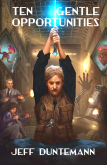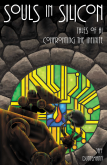- The only thing harder than selling a novel is finishing one.
- From Chris Gerrib comes a link to Smithsonian’s marvelous tale of The Great New England Vampire Panic.
- At least “vampire” isn’t a funny word. I can’t say “tatzelwurm” without giggling.
- From the Things-I-Didn’t-Know-Until-Yesterday Department: The “dead men” in that fine old drinking song “Down Among the Dead Men” are empty bottles, generally set on the floor under the tables.
- From ditto: Rice is an arsenic magnet. Eat with care.
- Here’s a gallery of applications and utilities written in Lazarus.
- The original 6-CD changer stereo in my 2001 Toyota 4Runner has failed, after working flawlessly since April 2001. Any suggestions as to a replacement? The car’s great. But I won’t drive very happily without music.
- As we gradually replace hundreds of millions of print books with ebooks, what will happen to our print books? Well, at least some of them may become color-coordinated accessories for people who don’t read. (Thanks to Esther Schindler for the link.)
- The price of bacon is about to skyrocket, while Americans enjoy the cheapest beer on Earth. Why do I always back the wrong horse?
- I guess compensating for a bacon shortage may be the striking tornado shortage going on right now.
- Be careful what you try to invent. You might succeed. More or less.
history
Odd Lots
Odd Lots
- Movers are coming imminently to reassemble my lower level, so I will be mostly out of touch for the rest of today.
- If you’ve never had an account with Verizon in the past, don’t get one now. Verizon sold a huge number (over a million!) of expired debt accounts to a debt collection agency called AFNI, which has been attempting to collect on some of them, even when the debt has long since passed over the horizon of the statute of limitations. Some of these debts were long since paid off, some were mistakes, and some may possibly be complete inventions. Verizon’s action was legal; AFNI’s may not be. Still, Verizon started it, and I’m encouraging people not to do business with them.
- Here’s an aurora prediction site I’d not seen before. We’re a little too far south to get much from the current outbursts, but having seen some of the 2005 auroras here (if barely) I’m certainly watching that red line. (Thanks to Jamie Hanrahan for the link.)
- From the Words-I-Didn’t-Know-Until-Yesterday Department: A tuya is a volcanic landform created by a smallish volcanic eruption that occurs under a kilometer-class ice sheet, as from our most recent ice age.
- Roy Tellason wrote to tell me about his tube data sheet page, which has more scanned data sheets (all PDFs; typically under 1 MB) in one place than I’ve ever seen, with no ads nor any fussing (registration, etc.) required to access them.
- Rich Rostrom sent a wonderful link to a collection of photos and drawings of the Hindenburg, including its passenger areas, which included (egad) a smoking room! Originally (it was later expanded a little) the airship could carry only 50 passengers, tops. Those must have been expensive tickets…
- I was starting to get this message almost fifteen years ago: Heart disease is about inflammation. It’s not about meat or fat. Inflammation comes from smoking, chemicals of various sorts, infections, and (most commonly) sugars and vegetable oils. No inflammation, no heart disease. (Thanks to Mike Bentley for the link.)
- I’m shopping for vacuum tube intercoms, and found that someone on eBay has listed the Talk-A-Phone set that my parents bought (they were made in Chicago then) and used as a baby monitor after my sister was born. I’d really prefer one of the mid-60s tube-based carrier-current models. All the majors had them. (Carol wants a better way to reach me when I’m in my office than yelling down the stairs…)
- The beautiful 1920s Des Plaines Theater has reopened after some major restoration, and is now slotting upscale live acts rather than movies. It’s literally around the corner from our Chicago-area condo, and I’m itching to find an event as an excuse to go in and look around.
- If you’re afraid of spiders, don’t go to Australia for awhile. (Thanks to Pete Albrecht for the link.)
- Dinosaur fossils don’t get a whole lot better than this.
- While doing my semiregular scan for pirated copies of my books, I happened across something fascinating on alt.binaries.e-book.technical: a scan of the original service manual for the Nazi V-1 flying bomb. I don’t know how to create an NZB that points directly to the file, but the item was posted on 10/25/2011. Search for “Gerate-handbuch FZG-76”. A dieselpunk pulse-jet is what it was, and now you can see what was inside it. (Being able to read German is a plus, but the photos are very good.)
- A wonderful photo collection of vintage ice-cream trucks. We saw the Good Humor trucks regularly on our street in the 50s and early 60s. The driver rang bells by pulling on a string. He did not play obscure hymns or creepy recorded voices saying “Helllo!”
- How’s your scene? (I had to look it up to see what a “scene” was in this context.) My “scene” is not listed, but you can see what the chap thinks of steampunk. And if you want a timeline, it’s here. (Alas, it starts in…2000. Do you feel mondo-creaky old looking at this? I do.)
Odd Lots
- I was wrong about Diesel engines being easy to make, as I suggested in my entry for March 5, 2012. Fuel injection, as it turns out, is a bitch. You’re trying to divide oil into a multitude of very small droplets of (reasonably) consistent size. Gasoline carburetion, by comparison, is a snap. (Thanks to Pete Albrecht, an automotive engineer, for the reminder.)
- I suspect it’s easier to produce wood gas (AKA “producer gas”) at a small scale than gasoline. In a future where large-scale oil refiners are no more, a Dieselpunk society could power internal combustion engines with wood gas. This has been done a lot around the world, especially during WWII when oil supply channels were disrupted.
- This has little or nothing to do with the Holy Roman Empire, but if you’re a map freak, boy–budget a day for it. Wow.
- This looks like a good book, especially if you’re finding it hard to keep track of genre mutation within SFF. Will order and report after reading. (Thanks to Trudy Seabrook for pointing it out.)
- We found one of these in a drawer in my late grandfather’s workbench after my grandmother died in 1965 and we had to sell their house. I never knew what it was until it made the A-head story on the front page of yesterday’s Wall Street Journal , in an article about…olympic sheep shearing. My grandfather lived a quiet life in a modest house on a tiny lot on Chicago’s north side. There wasn’t a sheep for miles. (I hope he didn’t use it to cut my father’s hair.)
- I’ve noted some confusion about this: “Retina display” is not an Apple trademark, but a technical term: a display with such high resolution that the eye can’t make out individual pixels at typical reading distance. Here’s a good explanation of the whole retina display concept. The new iPad certainly qualifies, but it wasn’t the first. Asus’ Tranformer Prime was there some time ago. Retina-quality displays are made by several vendors, and will eventually appear in other high-end tablets.
- The Lytro camera has been mentioned in a lot of places, but here’s the first in-depth description I’ve seen. A camera that allows you to fiddle with the focus after the shot is taken is FM, if you know what I mean. I ditch about a third of my digital photos (mostly taken in bad light) for focus problems. It’s an awkward form factor, but if it’s the first of it’s kind, I’ll assume the next one will fit the hand a little better.
- The mad scientist in me cried out when I saw this. I need a castle. I need a kite. I need a monster.
Odd Lots
- You can anodize titanium to give it a color finish using ordinary household ingredients like Coca Cola and electrons. Lots of electrons. (Alas, I don’t have enough Coke here to dunk my A-12.)
- The more I look at devices like this, the more I feel that it represents the future of high-end mobile computing. I also think it will accelerate the evolution of mobile device UIs, which are not in any shape (currently) to be productive in content creation or editing.
- This seems just, well, nuts to me, but people are using Usenet as a backup mechanism. Just bundle your stuff up in an encrypted binary file and post it to any binary group at all. With Giganews now providing 1300 days (!!) of binary retention, it could work…if you encrypt it strongly enough. (I remember the time when binary retention was six or seven days.)
- Many people have never heard of the “lineman’s splice,” which is way of joining two wires so that the join is in fact stronger than the wire itself. Now that NASA has endorsed the splice, it may see a renaissance. Only one problem: The drawing in the article is wrong. Can you spot the problem?
- I’ve always been a fan of “hi-rails,” which are small railroad vehicles used to run around the trackage looking for damage to rails and ties. Today, as often as not, they’re street pickup trucks with added small liftable flanged wheels, allowing them to operate on both rail and road. In times past, they were often street sedans with big flanged wheels and even cowcatchers. I consider them Dieselpunk, but I’ve never seen them mentioned in SFF.
- Of course, in the Steampunk era (or if your railroad was especially cheap) you had to pedal around the tracks yourself.
- An answer to a question I myself have never thought to ask: Why does it take less milk or cream to lighten iced coffee than hot coffee?
- I don’t even tweet with a keyboard yet, but with an Arduino and my trusty straight key, I’d have a long leg up on tweeting via Morse code.
- This is not the kind of glow-in-the-dark index you want to be high on, trust me.
An Informal Theory of Tribalism, Part 1: Background
I’m much of the way through an excellent book: The Better Angels of Our Nature by Steven Pinker, whose previous works on my shelves here include How The Mind Works, The Language Instinct, and The Blank Slate. The book’s dual mission is to demonstrate with hard research and reliable numbers that violence in human societies has declined and continues to decline, and perhaps to explain why. So far I’m persuaded by the first element of its mission. The second, well, I’m not as sure–but I’m also not finished with the book. However, I’ve read enough to recommend it, assuming you don’t mind long, dense books that require focus and an open mind to get through. The Better Angels of Our Nature provides solid backing to the impression Colin Wilson gives in his 1984 tome A Criminal History of Mankind: that the past was a bogglingly cruel and violent place, not only in certain parts of the Earth and in certain societies, but everywhere. Today, by contrast, we live in the safest and most peaceful era in human history. The improvement has not been linear, but graphed over centuries (and not merely years or decades) it’s been steady. This is counterintuitive if anything is. Still, the citations Pinker presents are beyond my ability as an amateur historian to challenge. Much of his thesis involves things I’ve not read of in detail before. Pinker’s description of the widespread practice of infanticide in our past is especially chilling. I may recognize the evolutionary logic for some of it, but the repugnance nearly all of us feel when contemplating the idea reflects how far we’ve come.
In short, we are not fallen angels. We are risen apes.
I’ve had a suspicion for quite a few years that the root cause of human cruelty and violence is tribalism. Pinker’s book provides more evidence that I was right. He cites a number of causes of violence, but most of them are either the consequences of tribalism, or tribalism outright. Furthermore, tribalism is something primal, something we inherited from the killer primate ancestors we share with creatures like gorillas and chimpanzees, who are enthusiastic and highly calculated murderers of their own kind. We see it in our own historic records as far back as they go, and also in the societies of aboriginal peoples who have avoided contact with modern societies until recent times. (Jared Diamond has written much about his experiences with recently contacted tribes in the new Guinea highlands; see The Third Chimpanzee for a sample.)
It’s easy for those of us in the Intellectual Elite to cluck and roll our eyes at any suggestion that tribalism is still with us. Don’t. What we’ve made great progress suppressing are warfare and murder, mostly by sheer dint of will enforced via societal pressures against fountains of violence like polygamy (polygyny, more precisely) and honor cultures. We’re still having trouble with deeper evils like idealism, but idealism is not a consequence of tribalism. (It certainly takes advantage of tribalism, as Marxism did with great success in the past hundred-odd years. Let’s not confuse the horse with the rider, even if both need shooting.) Tribalism is very much with us, and whereas it causes less murder than it used to, it still shapes our thought and our societies in ways that should give us pause. It generates hatred like nothing else out there, and enslaves even the brightest of us.
The quickest way to find evidence is to read the comments sections of forums covering anything less technical than the alignment of IF strips. Everyone knows what flamers and trolls are. They’ve been around since there were online forums. I saw them in my bang-path days in the early 80s. Anonymity amplifies the temptations to flame and troll; see the very brilliant take that Penny Arcade has on the topic. I was a little surprised to see how much the psychology of flaming and trolling is rooted in tribalism. As with a lot of insights, once I knew what to look for I saw it everywhere. I’ve actually engaged the trolls here and there, to see how they react to certain kinds of provocation. (If you ever stumble across any otherwise uncharacteristic or inexplicable posts of mine online, it’s almost certainly me poking a troll with a stick and taking notes.) I now think I know enough to summarize my research and toss out an informal theory of tribalism, especially as it applies to our online world.
The series here will not be contiguous. It’s a difficult thing to write about, and I have other topics on my do-it list, most of them more fun if less provocative than this. I do want to ask that you put on your Cloaks of Heroic Courtesy before you click the Comment link. I always welcome thoughtful and polite discussion. However, if you insist on flaming or trolling, I have a perfect opportunity to tap my pointer on our virtual blackboard and use you as an example: “Kids, here’s still more evidence supporting my theory. Let me explain what’s going on in this comment…” Be the student. Don’t be the lesson.
Next: What tribalism is.
Daywander
Why would anyone read two histories of Byzantium? Well, if the first one is mainly useful in putting you to sleep on a bad night, you might need a second to actually understand Byzantium. I finished John Julius Norwich’s A Short History of Byzantium about six weeks ago, and I suspect it didn’t satisfy because it was, well, short. (It’s an abbreviation of a much longer 3-volume work by the same author.) Norwich tells us all the things that happened in the eleven hundred years that the Byzantine empire existed, but he doesn’t have room in a mere 400 pages to analyze why things evolved as they did. By the time I was done, the Byzantine empire seemed to cook down to pseudocode:
REPEAT
New(Emperor);
Rivals.SlitThroat(Emperor)
UNTIL MuslimsKnockOverConstantinople;
So unless you’re an insomniac like me, I recommend A History of Byzantium by Timothy E. Gregory (Blackwell, 2005) which trades some of the repetitive detail for more and better analysis. It’s a much more readable book overall, and seems targeted at laypeople who don’t already know the broad outlines of the story. (I’m guessing it’s a 300-level textbook.) Recommended.
In other recent reading, I went back to Colin Wilson’s New Pathways in Psychology (Taplinger, 1972) to locate his definition of a “self-actualizer,” which may help me in designing a character for an upcoming story. The book is an explication of Abraham Maslow‘s views on psychology, which Wilson admires and mentions in many of his other books. I ended up reading a lot more than I intended, and realize that I may have to buy another copy of the book. The one I have was cheap, sure, but it was previously owned by a person who underlined probably 50% of the book without more than a handful of marginal notes. How is it useful to have all that underlining, if the purpose of underlining is to call attention to especially brilliant or pertinent passages when you want to find them later? And when she (her name is on the flyleaf) decides to make a note, it only proves that she is stone deaf to Colin Wilson’s ironic sense of humor.
I’ll come back to Wilson’s books in a future entry on designing characters, but in the meantime, New Pathways in Psychology is useful, as is A Criminal History of Mankind (Mercury, 2005.) His 1956 breakout book, The Outsider, nails existentialism–right through the head. Not as engaging as his other work, but if you’re trying to design a disaffected young man (especially if you yourself are well-adjusted and generally happy) the blueprints are all right there.
Yesterday Amazon delivered the 32 GB MicroSD HC card I’d ordered for the Droid, and I had this insight: You know you’re old when the fact that a thing the size of your pinkie fingernail could swallow everything you’ve ever written without a burp (plus ebook editions of every book in the house, if they existed) still makes you boggle. I don’t know precisely how much stuff it could hold because I don’t have that much stuff. But I’ll do some math: At 3 MB per MP3, the card could hold 10,000 songs. At 3 minutes per song, that’s 30,000 minutes, or 500 hours of music. At 500 KB for an .epub novel, that’s 60,000 novels, which at a novel every single night is…165 years’ worth of novels.
I guess I’m old. My boggler is in excellent working order.
Odd Lots
- Does anybody here use true peer-to-peer chat? I don’t use chat much, and when I do it’s with a very small number of people, typically one-to-one. By peer-to-peer I mean via direct connect from one IP to another, without intermediation at the server level, as with things like Trillian, Skype, Jabber, etc. I know that WASTE does this, though I’ve never tried it. What else might work? I don’t want to mount a new server if I can avoid it.
- New research suggests that low-salt diets increase insulin resistance–and thus propel otherwise healthy people toward diabetes. (Via Fat Head.)
- More on Amazon’s rumored Android tablet. Print Replica (as I discussed in yesterday’s entry) has almost nothing to do with it.
- Note well: Sony’s new tablet is not really sideload-able, since the device cannot render content directly from an inserted SD card. You have to copy all material from the card to internal storage. Also, the weird cross-section makes it almost inescapably a landscape machine. No thanks.
- Interesting short piece on the other Delphi–as in, Oracle of.
- For those who asked: The 400W power supply I just bought for my Core 2 Quad is the Antec Neo Eco 400C. So far…love it!
- Having sold out all the TouchPads there were at fire-sale prices, HP now intends to…make some more. Something flaky here: Lose a little money on each sale, and make it up in volume? Doesn’t add up…unless it was a slick and risky attempt to build a demand base.
- Didn’t know this before: Setting a .jpg to quality setting 7 in Photoshop degrades the image’s quality. Stay at 6–or bump to 8.
- How about Han Solo Carbonite Slab ice cubes? Brilliant gimmick, though I wonder (given that the product is marked as “unavailable”) if they’re really out of stock or just didn’t close the deal with Lucasfilm.
Odd Lots
- Freedom matters, and in honor of Independence Day here’s an eye-opening report on the “state of freedom” in the fifty American states. I knew a lot of this from my research nine years ago, when Carol and I decided to leave Arizona, but it’s nice to see it all in one free (in the other sense) document.
- From the Words I Didn’t Know Until Yesterday Department: draisine, a human-powered device for moving over railroad rails. This is evidently a European term; over here these are called handcars or inspection speeders or rail cycles or a number of other things. Definitely note the hot-pink draisine-built-for-two on the Wikipedia page. (Thanks to Aki Peltonen for dropping the word to me.)
- Although I’m sure that everyone in the civilized galaxy has seen the cartoon, I wasn’t aware that “thagomizer” is now paleobiological jargon. (Thanks to Pete Albrecht for the link.)
- Here’s a list of somebody’s picks as the ten best hard SF books of all time. I agree with about 50% of the picks, though Robinson’s Mars trilogy was so slow and padded-out that I could barely finish it. (I have not yet read the Egan book cited.) I sense as well that Somebody Doesn’t Like Heinlein’s Politics. (Thanks to Frank Glover for the link.)
- Despite a 500-fold increase in cell phone use in the last 20 years, malignant brain tumor diagnosis is down in that timeframe. This interests me, as three people I knew died of brain tumors (the largest cancer cluster in my circle of acquaintance) and it makes me wonder. (Thanks to Pete Albrecht for the link.)
- I had just a couple of comic books back in the early Sixties, and one of the most intriguing was an extra-long number from DC called Secret Origins that had the backstory for five or six of the most famous DC superheroes. Oddly, what I remember most clearly was the backstory for Green Lantern, especially the little blue guys on the Planet Without Consonants and (most intriguing of all) a power ring with a flaw that prevented it from working against anything yellow. Trouble is, if you remove the flaw, the ring loses its power completely. Now that’s cool–alas, in what may be the canonical Green Lantern for Dummies page, the yellow gotcha isn’t stated clearly and I wonder if it was just abandoned back in the 1960s.
- Forgot to aggregate this back in January: One of the most bizarre articles I’ve ever read on any major site in recent years. This totally, completely, utterly certain guy is angry at other guys for being totally, completely, and utterly certain–and that about something totally, completely, and utterly trivial. My take: We “know” nothing at all with certainty, and the more certain you are that you’re right, the more certain the rest of us should be that you’re wrong. Nyah-nyah!
- And another Odd Lot that has lain around for some time: Polish troops trained a young bear to carry ammo during the Battle of Monte Cassino. My father was at that battle, working a radio station on the back of a truck, but he never mentioned seeing the bear. The bear is said to never have dropped any munitions, which I’m sure was a good thing for the bear, and possibly my father as well.
- Here’s a bogglingly weird Dickensian artifact that I’d never heard of before: A key gun. It’s a gun built into the key to a (large) prison cell lock. I’m sure if it had worked better I would have seen it before now.
Odd Lots
- As I write this mid-afternoon on May 2, 2011, we’re in the thick of something approaching a blizzard here on the slopes of Cheyenne Mountain. This is probably the coldest spring here since we arrived in April 2003. The beautiful warm weather of May, 2002 (when we first discovered Colorado Springs) might have been a fluke. Or maybe this is. No one can tell me.
- Here’s an interesting take on the value of media images as symbols, and to some extent supports what I said yesterday about Bin Laden’s death: We did our best not to leave images around to be turned into revered icons. That, coupled with the native Muslim caution about idolatry, will limit the man’s future power as a martyr.
- Fascinating bit of Old West history: Bass Reeves, one of the most successful US Marshals of his or any era, was black. (Thanks to Nick Hodges for the pointer.)
- VE3EN is losing his job mid-year, and his marvelous solar data aggregator may go dark. That would be a tragedy, though I’m not sure what can be done.
- I think I’m going to make one of these.
- Would a power-cord tethered high-resolution touchscreen all-in-one make a good armchair ebook reader? A smaller unit like this one could be, and would provide enough resolution to read art-heavy PDF-based ebooks without eyestrain, even with old eyes like mine. Now if they’d just allow us to take the legs off…
- Mercury, Venus, Mars, and Jupiter are now visible in the east just before sunrise, and if you look quick you’ll see them all. (Mercury is the tricky one.)
- If you like volcanoes, Oregon State University has a nice aggregator for eruption news. There are some terrific photos here, and scary ones.
- Is this what it means to “sit on your brains”?
A Very Bright Line
Today’s Big Question cooks down to this: Is Bin Laden more valuable to Al Qaeda as a live leader or a dead martyr?
Hint: Name one Islamic martyr.
Here in the mostly unchurched West it’s easy to forget that Islam is an expression of radical monotheism. Islamic culture brooks no competitors to Allah, and takes the Old Testament proscription of “graven images” farther than any other major religion. It’s not about the images themselves, as we sometimes misunderstand, but about the underlying psychology of worship.
Catholicism’s great genius lay in absorbing the pagan cultures it converted rather than destroying them, and in consequence we revere saints and sometimes inanimate objects that are images of saints, are associated with saints (relics) or express sacred symbols. These are Christianized echoes of ancient polytheism, and looking at the myths of early Christianity, it’s easy to see the saints in the stories as small-g gods: They are larger-than-life because, well, they are larger than life, and have ascended into a graduated pantheon that from ancient times expressed the connectedness of humanity to the divine. A single, all-powerful God is a relatively recent addition to religious psychology, but Christianity simply placed God at the top of the pyramid, with all the saints below, revered but not worshipped. (I grant that drawing that line has always been a challenge.)
Here and now we’re comfortable with that, but a close reading of Eastern history shows the sometimes bloody tension between monotheism and these ancient echoes of polytheism. I just finished John Julius Norwich’s A Short History of Byzantium, which went into considerable detail about iconoclasm, a religious conflict that tore through the Byzantine Empire circa 750. People were killing one another over questions of what should be revered, and how. (I think it’s no coincidence that Islam itself appeared barely a century earlier.) Byzantium basically anathematized representational sculpture in the eighth century, and afterward confined religious artwork to painted (not graven; i.e., shaped or sculpted) images. This was a compromise. Many in the iconoclast faction at the time wanted no representational art at all.
Islam goes farther still. It reveres the ancient prophets (up to and including Mohammed, considered the greatest and the last) but demands that worship be directed to God and God only, and is constantly on guard against the temptation to idolatry. Living leaders provide inspiration and are given obedience, but once leaders die, they move into God’s territory, and some very strict rules begin to apply to those still on Earth. Revering a deceased leader too much begins to resemble idolatry, and Muslims have a very deep caution about idolatry.
We in the West don’t call it “hero worship” for nothing.
My thought is that Bin Laden’s death will be an inspiration to his followers, but not too much and not for long. He was a very bright guy, skillful and extremely lucky, and Al Qaeda will miss him sorely as a leader. His power as a martyr and a symbol will be limited, however, in a religion where history and hagiography are separated by a very bright line.











